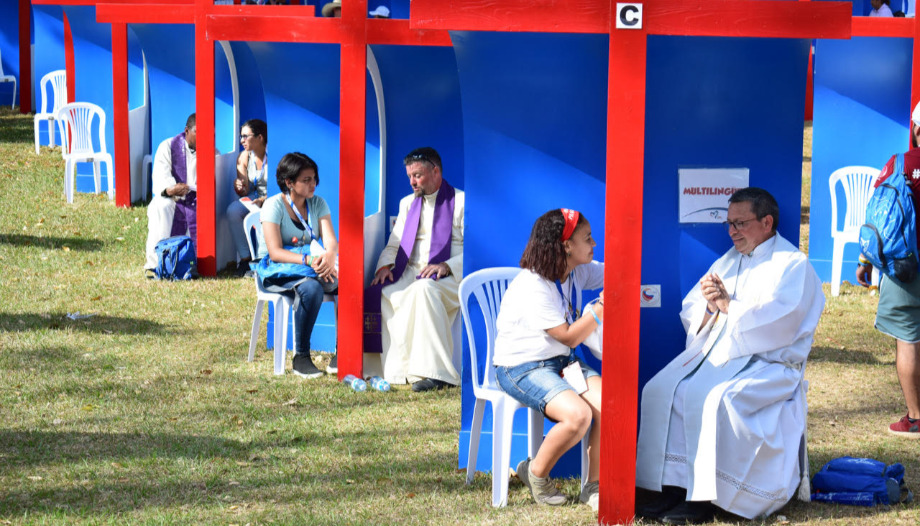We saw in the previous article the meaning of the sacramentsand why they are celebrated as they are celebrated. We said that the seven sacraments correspond to all the important moments of the Christian's life: they give birth and growth, healing and mission to the Christian's life of faith. The Eucharist occupies the center, for it contains the Author of the life of divine grace, Christ himself; on the other hand, through God's mercy and forgiveness, the sacrament of Penance achieves the healing of the sick soul - fallenness - and thus makes possible the growth of love for God.
What are the material element, human gestures and words in the sacrament of Penance?
The Council of Trent established as doctrine that the sensible sign of this sacrament is the absolution of sins by the priest, as well as the acts of the penitent.
The matter would be the contrition or sorrow of heart of having offended God, the sins said to the confessor in a sincere and integral manner and the fulfillment of the penance or satisfaction. In this regard, it should be emphasized that for the validity of the sacrament, the obligation to confess all mortal or grave sins of which one is conscious must be observed.
On the other hand, the form would be the words pronounced by the priest - who at that moment is Christ himself, since he acts "in persona Christi" - after hearing the sins: "I absolve you of your sins, in the name of the Father, the Son and the Holy Spirit".
There are two fundamental elements in the celebration of this sacrament. The first is constituted by the acts performed by the penitent who wants to convert his heart in the presence of God's merciful love, thanks to the action of the Holy Spirit: repentance or contrition, confession of sins and the performance of penance. The other element is the action of God: as the Catechism states in point 1148, through priests the Church forgives sins in the name of Christ, decides what the penance should be, prays with the penitent and does penance with him.
Ordinarily, the sacrament is received individually, going to the confessional, telling one's sins and receiving absolution also individually. There are exceptional cases-practically the state of war, danger of death by catastrophe, and a notorious shortage of priests-in which the priest can impart general or collective absolution: these are situations in which, if not imparted, persons would remain unable to receive the sacramental grace for a long time, through no fault of their own. But this does not exclude penitents from having to go to individual confession at the first opportunity and confess the sins that were forgiven through general absolution.
Finally, one could refer to general confession: when a person makes a confession of all the sins committed during a lifetime, or during a period of life, including those already confessed with the intention of obtaining greater contrition.
Why do we also speak of the sacrament of "confession", "reconciliation", "God's forgiveness" and "joy"?
The sacrament of Penance is called the sacrament of "confession" because the declaration or manifestation of sins before the priest is an essential element of it. It is a recognition and praise of God's holiness and mercy towards sinful man.
It is also known as the sacrament of "reconciliation" because it bestows on the sinner the love of God, which reconciles. Thus the Apostle Paul advises the Corinthians: "Be reconciled to God" (2 Cor 5:20).
It is called the sacrament of "forgiveness" because through the priest's sacramental absolution God grants the penitent the forgiveness of his sins.
Finally, it is also the sacrament of "joy" because of the peace and joy obtained after receiving the forgiveness of a Father who understands his children and dispenses his merciful love as often as necessary.
What are the material element, human gestures and words in the sacrament of the Eucharist?
By way of introduction and clarification, it should be noted that the word "Eucharist" refers both to the celebration of the Holy Mass and to the sacramental presence of Christ, which in fact can be reserved in tabernacles or tabernacles.
The matter of the sacrament of the Eucharist is bread of unleavened flour and natural wine, extracted from grapes, as used by Jesus Christ at the Last Supper.
The form refers to the words pronounced by the Lord at the institution of the sacrament, a moment of the Mass called "transubstantiation", since the bread and wine cease to be bread and wine and become the body and blood of Jesus Christ: "Take this, all of you, and eat of it, for this is my Body which will be given for you" (...) "Take this, all of you, and drink of it, for this is my Blood. Blood of the new and everlasting covenant which will be shed for you and for many for the forgiveness of sins".
The bread and wine are placed on the altar, an element that liturgically represents Christ and therefore converts this "placing" into an "offering". It is a spiritual offering of the whole Church that gathers the life, sufferings, prayers and labors of all the faithful, which are united to those of Christ in a single offering.
In his message to the Roman pilgrims on the Lent 2018 Pope Francis recalled that every Eucharist consists of the same signs and gestures that Jesus performed on the eve of his Passion, at the first Eucharist.
These signs are represented in the Eucharistic liturgy -or celebration- with a multitude of gestural details that the priest celebrant of the Holy Mass puts into action: opening his arms in the form of a cross to signify the sacrifice hidden in the Eucharist, kneeling as a sign of adoration and recognition of the greatness of God, raising the chalice and paten as an offering to the Highest, etc.








